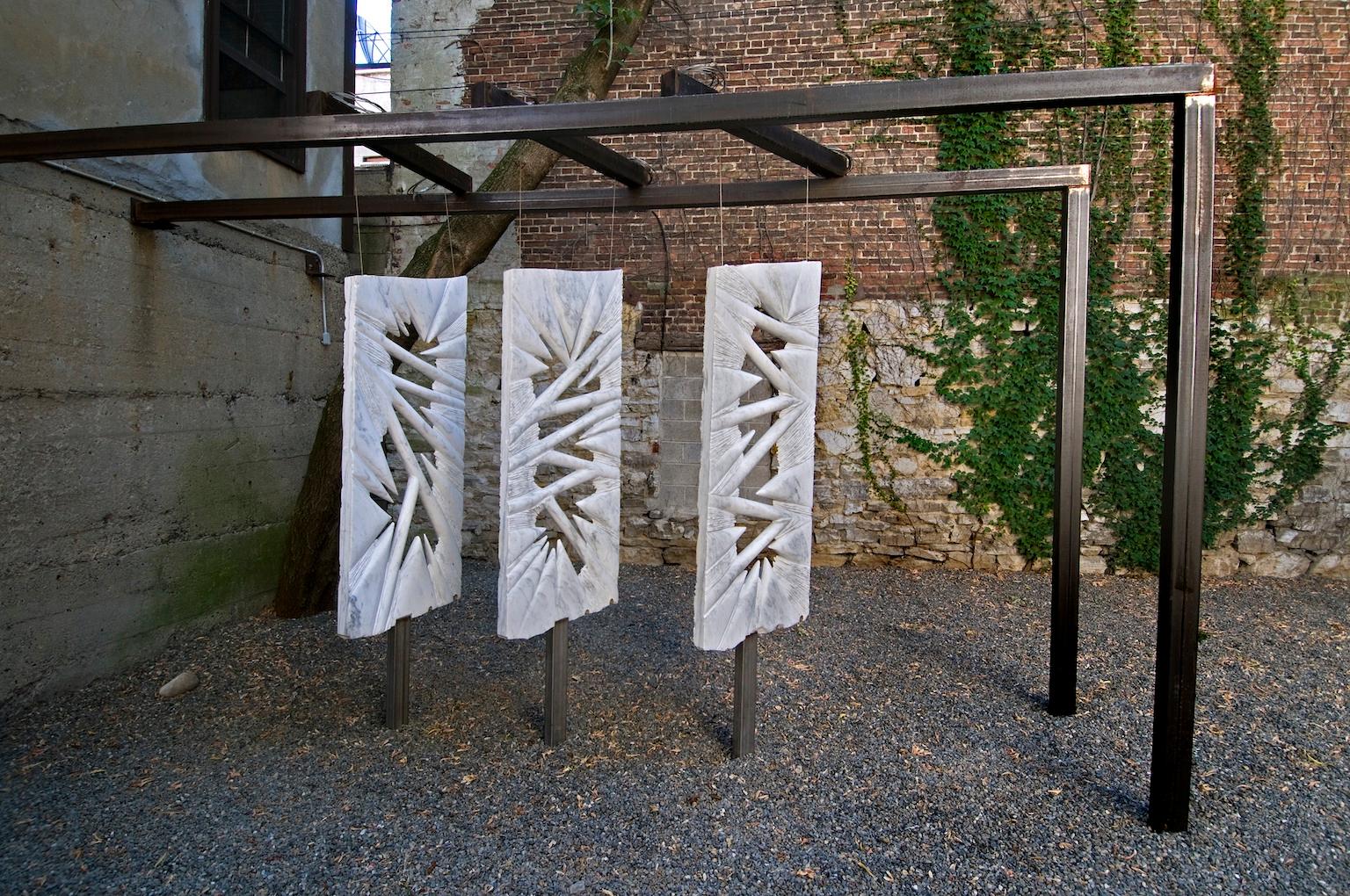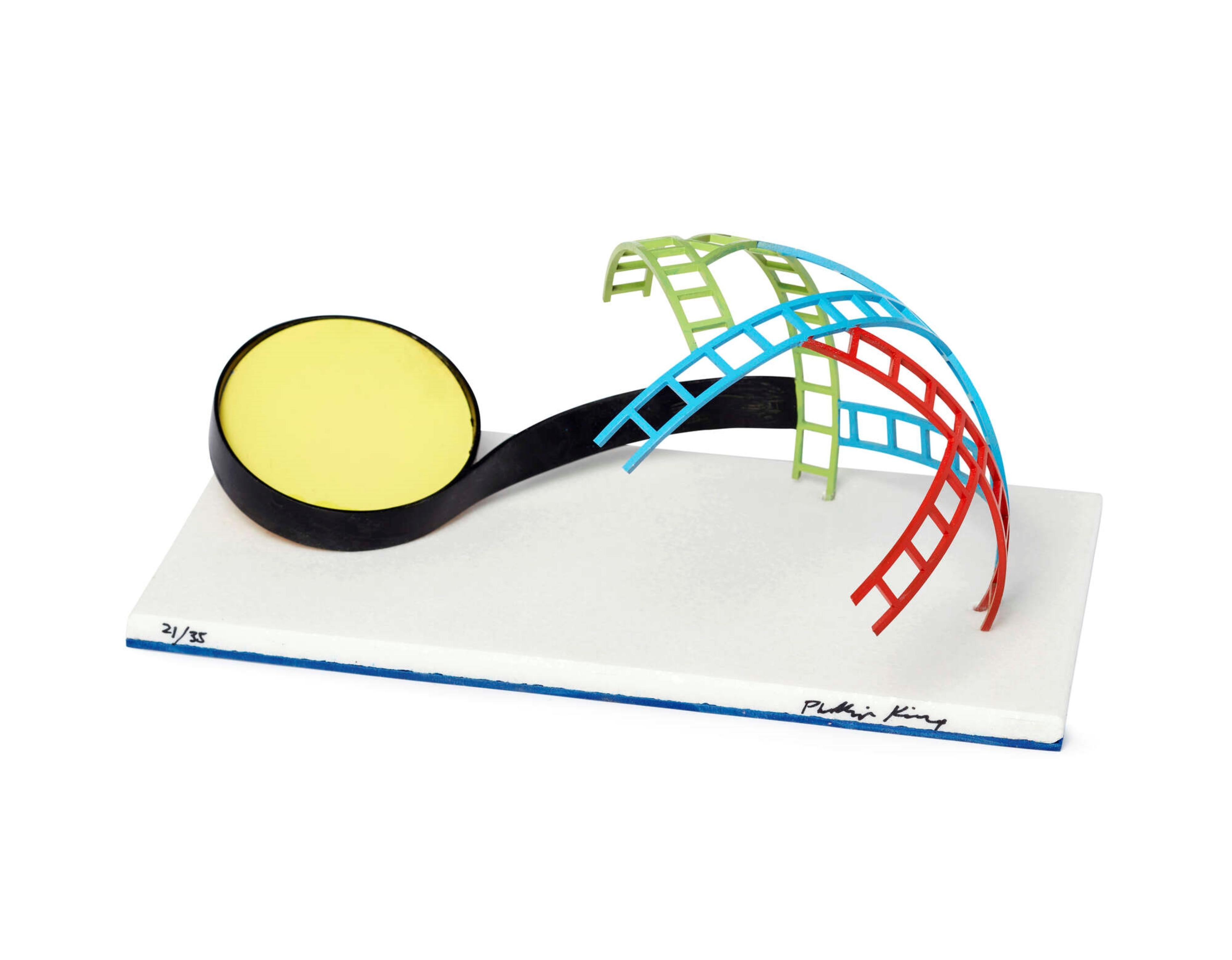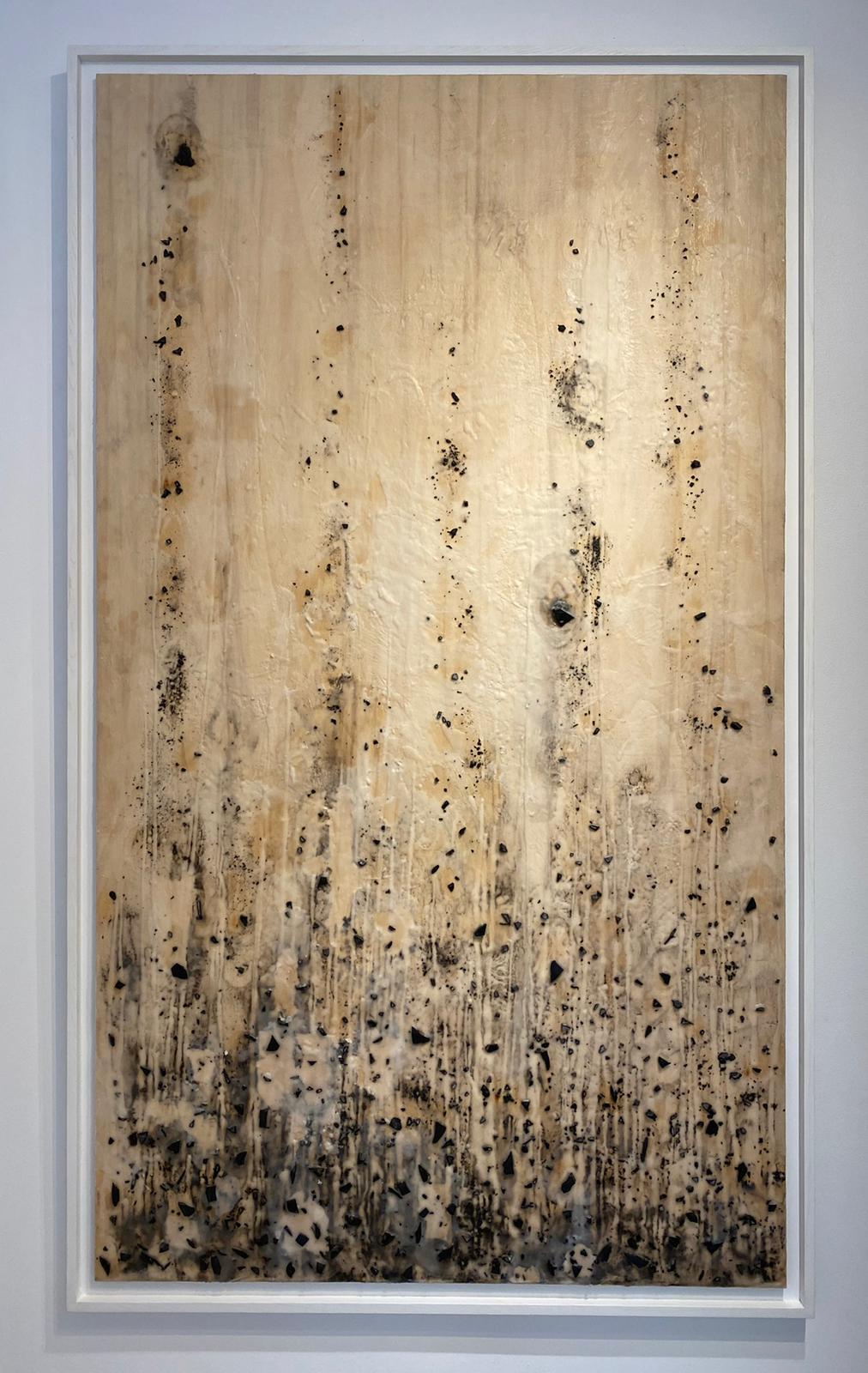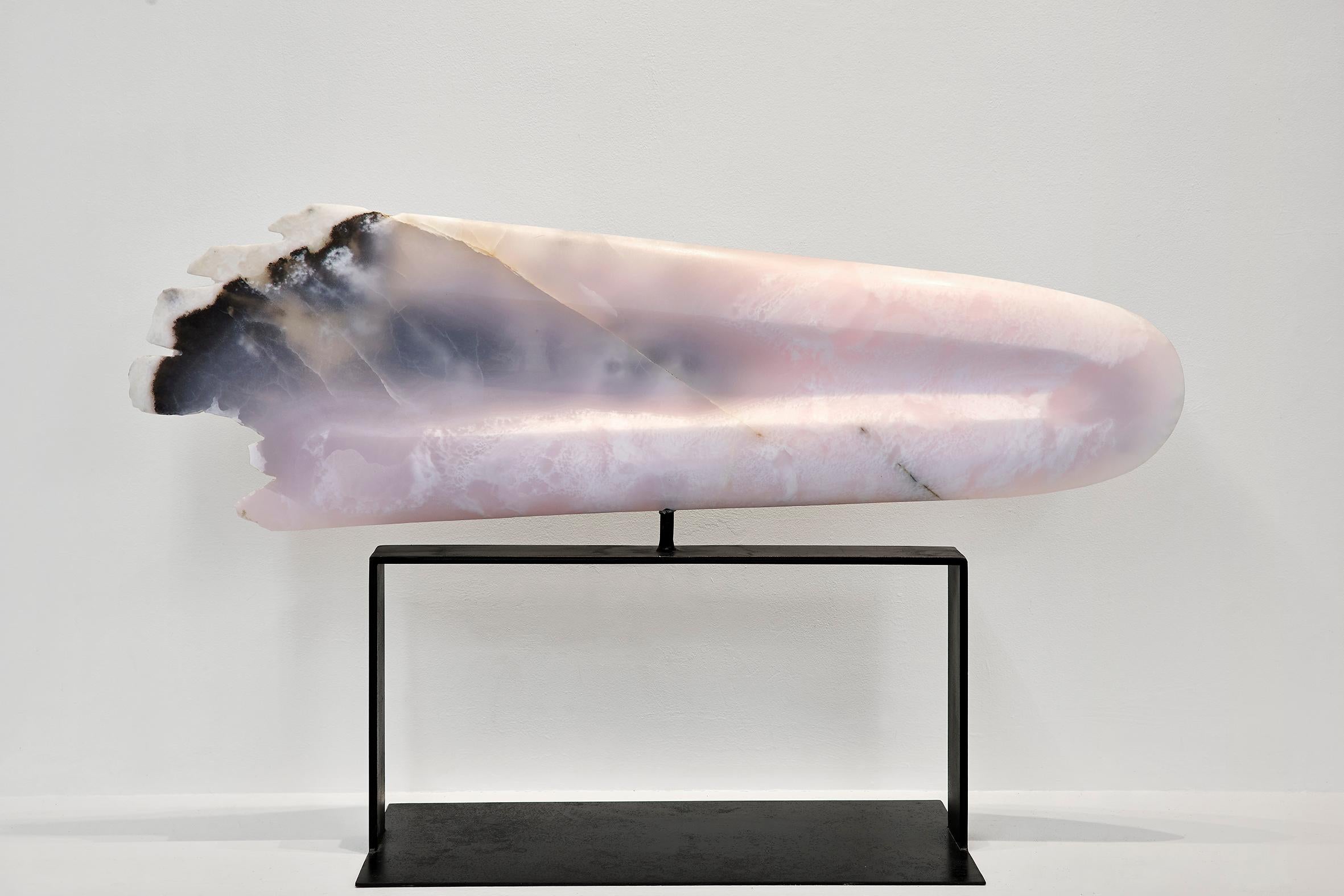Items Similar to Pedro Barreto, Esfera, Marble, ø 25.6 in. ø 65 cm
Video Loading
Want more images or videos?
Request additional images or videos from the seller
Pedro BarretoPedro Barreto, Esfera, Marble, ø 25.6 in. ø 65 cm Undated
Undated
About the Item
Pedro Barreto
Esfera, Undated
Marble
ø 25.6 in. ø 65 cm (Depth 5.9 in. 15 cm)
Base: 7.9 x 7.9 x 9.8 in. 20 x 20 x 25 cm
Pedro Barreto (b. Santa Catalina, Venezuela, 1935; d. Lechería, Venezuela, 2008)
His first experiences as a sculptor were with wood, influenced by his place of birth in the Orinoco River delta.
Between 1954 and 1958, he studies at the Plastic and Applied Arts School of Caracas.
In 1957, his first one-man exhibition took place in Tucupita, earning him a scholarship to study in Europe.
He attends the School of Fine Arts of Rome until 1960, after which he travels to Paris and works in Agustín Cárdenas’ studio.
In 1973, he is awarded Tokyo’s Shinsakasho Prize and Venezuela’s Salón Arturo Michelena.
- Creator:Pedro Barreto (1935, Venezuelan)
- Creation Year:Undated
- Dimensions:Height: 33.5 in (85.09 cm)Width: 33.5 in (85.09 cm)Depth: 9.8 in (24.9 cm)
- Medium:
- Movement & Style:
- Period:
- Condition:
- Gallery Location:Miami, FL
- Reference Number:1stDibs: LU161328909812
About the Seller
5.0
Vetted Seller
These experienced sellers undergo a comprehensive evaluation by our team of in-house experts.
Established in 1989
1stDibs seller since 2021
Typical response time: 1 to 2 days
- ShippingRetrieving quote...Ships From: Miami, FL
- Return PolicyA return for this item may be initiated within 14 days of delivery.
More From This SellerView All
- Volumen VPC-062Located in Miami, FLVolumen VPC-062, 1972 Unique Piece Direct carving on Cumarebo stone 67 x 38 x 20 cm 26.3 x 14.9 x 7.8 in. ABOUT THE ARTIST Narváez was born in Porlamar, Venezuela, in 1905; he was the fifth son of eleven siblings; his parents were Jose Lorenzo Narváez and Vicenta Rivera. Don José Lorenzo, a multifaceted and creative man, sowed the seed of creativity in his son. “My father did not fit in with his fantasies of cabinetmaker, bricklayer, master builder, and self-taught architect.”1 From an early age, Francis was led to the artistic activity, he traced, carved, made replicas of the furniture and the saints restored by his father. In 1920 he obtained his first professional assignment, a San Rafael for the Church of Carupano, and, in 1922, his father authorized him to travel to Caracas to pursue his studies as an artist. He studied at the atelier of Marcos Castillo, at of the Angel Cabre y Magriña and at the Academy of Fine Arts in Caracas, where he was introduced to the painters and intellectuals of the time. In 1928 he presented his first solo exhibition at the Club Venezuela. With the money raised from the sale of the works and the support of Monsignor Sosa, and the Ministers Centeno Grau and Arcaya, he studied in Paris on a scholarship. Once there, he enrolled at the Académie Julian, where Tito Salas, Cristóbal Rojas and Arturo Michelena had also studied. It was in Paris where, unable to work in wood, he turned to stone carving. “In Paris, I didn’t have wood, so I carved a lot in stone (…), when there were demolitions I purchased chunks of stone, I would take them to the workshop and carve them.”2 His first attempts at volumetric sculptures and painting in plain colours, linked to the thematic of American miscegenation and Creole reality, can be traced back to that first trip to Paris. During his stay in the French city, Arturo Uslar Pietri, Alfredo Boulton, and Finita Vallenilla supported the artist both financially and logistically, and in February of 1930, the trio of friends arranged another exhibition for him at the Club Venezuela. Narváez describes his exhibition as follows: “(…) in it I feel that the sculptural work is more my own, done with more assurance, a response to my pursuit of large planes, stylisation and synthesis.”3 By then, as Boulton himself noted in his book about the artist, Narvaez departed from most of the artistic traditions that prevailed by that time in Venezuela. In 1931 he returned to Caracas and established his atelier at the Barrio Obrero in Catia. The atelier became the hub of the intellectual life of the time. “In those years, the atelier of Francisco Narváez was the hub of the greatest Venezuelan hope. Nothing comparable to it can be found either before or since.”4 From that year onwards, exhibitions, projects, trips, and awards we multiplied. He was awarded the President of the Republic of Venezuela Prize, the National Sculpture Prize of the 1st Official Venezuelan Art Salon, and the John Boulton Prize of the 3rd Annual Venezuelan Art Salon; for the Military Academy, he produced a spectacular relief entitled La Patria. In 1945, commissioned by the architect Carlos Raúl Villanueva, he produced two groups of sculptures known as Las Toninas, both located in the O’Leary Square. There, as he himself states, he incorporates some baroque patterns into the figures to the source itself: “It is a work of balance between the decorative requirements and the sculpture of planes and angles.”5 In 1948 he was awarded the National Painting Prize. In the same year, he was called upon by the architect Carlos Raul Villanueva to participate in the project for the arts integration in the Universidad Central de Venezuela. Francisco Narváez’s public output continued with works such as the statue of Fermín Toro, La Educación, La Ciencia, three murals (produced by María Luisa Tovar) for the Instituto de Medicina Experimental, El Cristo; el Atleta, the equestrian statue of General Rafael Urdaneta. In 1953 he was appointed Director of the School of Plastic and Applied Arts, and in July of the same year, he exhibited “Francisco Narváez, Maderas, Piedras y Bronces” (Francisco Narváez, Woods, Stones and Bronzes) at the Museum of Fine Arts. Narváez is, unquestionably, one of the great Venezuelan sculptors, his work goes through various stages and interests; as the art world evolves, the artist does not remain in his initial scopes of work. His creations are not imposed by the prevailing trends or fashion but do evolve by experimenting with new materials and interests. When one peruses the artist’s lengthy list of exhibitions, commissions, and awards, it is worth remembering the Narvaez who embark on his career as a child and who, overcoming obstacles, knew how to make the most of his curiosity. He did not settle for living off his successes. He did not remain stagnant as many creators of his environment did. Narvaez managed to understand the changes in the history of art around him. We must not overlook the fact that Francisco Narvaez is an artist amid all the changes occurring in the art world. He moves from the classics to the great transformations in the art world. It is the Europe of Picasso, Braque, Arp. He observes, he is aware of what is happening in the centres of the world of art, but between his craft and his sensitivity, the result is NARVAEZ, his stamp, and his identity. Francisco Narváez comes from tradition, and his first stage is linked to the classics, to the exploration of his heritage, but always with his very own language. Throughout his prolific career, he knew how to remain true to himself, without disregarding the influences of his surroundings or his artistic interests: his ability as a sculptor, his selection of materials, whether they were wood, stone or bronze; his choice of the subject of his work…His mastery and great craftsmanship are a constant that over time have made him a leading player in the history of contemporary Venezuelan and world art. From his beginnings, no subject was foreign to him. His paintings, drawings, aquarelles, and sketches are testimony to his prolific output. Among his themes are portraits, our traditions, still lifes, and landscapes. Narváez is an artist who represents his time. Later, he evolved towards purer and simpler forms, abandoning figurative art for short periods. In 1956 he declared to the newspaper El Nacional: “Every day I am freeing myself, it is a soul that frees itself from the ephemeral wrappings of the circumstantial always, as well as from the inevitable weight of the anecdote. This second stage of my work is remarkably close to abstractionism, even if there are still certain figures or figurations in the sculptures that I will shortly be showing. However, pure, and absolute abstractionism, it will treat the form itself as the sole reason for its existence on the plane of artistic excellence.”6 The artistic development was his professional life. Each period of his life as an artist, he went one step further, searching, solving, seeing plenty of things and understanding how diverse expressions were transforming themselves. His hands followed his gaze and his mind, always inquisitive. He added movement to the volumes. Arturo Uslar Pietri, “Formas Nuevas”, Cromotip editions, 1956 “Francisco Narváez is a path: the path that Venezuelan sculpture...Category
1970s Abstract Abstract Sculptures
MaterialsStone
- Volumen VPC-038Located in Miami, FLVolumen VPC-038, 1970 Unique Piece Direct carving on Cumarebo stone 40 x 32 x 20 cm 15.7 x 12.5 x 7.8 in ABOUT THE ARTIST Narváez was born in Porlamar, Venezuela, in 1905; he was the fifth son of eleven siblings; his parents were Jose Lorenzo Narváez and Vicenta Rivera. Don José Lorenzo, a multifaceted and creative man, sowed the seed of creativity in his son. “My father did not fit in with his fantasies of cabinetmaker, bricklayer, master builder, and self-taught architect.”1 From an early age, Francis was led to the artistic activity, he traced, carved, made replicas of the furniture and the saints restored by his father. In 1920 he obtained his first professional assignment, a San Rafael for the Church of Carupano, and, in 1922, his father authorized him to travel to Caracas to pursue his studies as an artist. He studied at the atelier of Marcos Castillo, at of the Angel Cabre y Magriña and at the Academy of Fine Arts in Caracas, where he was introduced to the painters and intellectuals of the time. In 1928 he presented his first solo exhibition at the Club Venezuela. With the money raised from the sale of the works and the support of Monsignor Sosa, and the Ministers Centeno Grau and Arcaya, he studied in Paris on a scholarship. Once there, he enrolled at the Académie Julian, where Tito Salas, Cristóbal Rojas and Arturo Michelena had also studied. It was in Paris where, unable to work in wood, he turned to stone carving. “In Paris, I didn’t have wood, so I carved a lot in stone (…), when there were demolitions I purchased chunks of stone, I would take them to the workshop and carve them.”2 His first attempts at volumetric sculptures and painting in plain colours, linked to the thematic of American miscegenation and Creole reality, can be traced back to that first trip to Paris. During his stay in the French city, Arturo Uslar Pietri, Alfredo Boulton, and Finita Vallenilla supported the artist both financially and logistically, and in February of 1930, the trio of friends arranged another exhibition for him at the Club Venezuela. Narváez describes his exhibition as follows: “(…) in it I feel that the sculptural work is more my own, done with more assurance, a response to my pursuit of large planes, stylisation and synthesis.”3 By then, as Boulton himself noted in his book about the artist, Narvaez departed from most of the artistic traditions that prevailed by that time in Venezuela. In 1931 he returned to Caracas and established his atelier at the Barrio Obrero in Catia. The atelier became the hub of the intellectual life of the time. “In those years, the atelier of Francisco Narváez was the hub of the greatest Venezuelan hope. Nothing comparable to it can be found either before or since.”4 From that year onwards, exhibitions, projects, trips, and awards we multiplied. He was awarded the President of the Republic of Venezuela Prize, the National Sculpture Prize of the 1st Official Venezuelan Art Salon, and the John Boulton Prize of the 3rd Annual Venezuelan Art Salon; for the Military Academy, he produced a spectacular relief entitled La Patria. In 1945, commissioned by the architect Carlos Raúl Villanueva, he produced two groups of sculptures known as Las Toninas, both located in the O’Leary Square. There, as he himself states, he incorporates some baroque patterns into the figures to the source itself: “It is a work of balance between the decorative requirements and the sculpture of planes and angles.”5 In 1948 he was awarded the National Painting Prize. In the same year, he was called upon by the architect Carlos Raul Villanueva to participate in the project for the arts integration in the Universidad Central de Venezuela. Francisco Narváez’s public output continued with works such as the statue of Fermín Toro, La Educación, La Ciencia, three murals (produced by María Luisa Tovar) for the Instituto de Medicina Experimental, El Cristo; el Atleta, the equestrian statue of General Rafael Urdaneta. In 1953 he was appointed Director of the School of Plastic and Applied Arts, and in July of the same year, he exhibited “Francisco Narváez, Maderas, Piedras y Bronces” (Francisco Narváez, Woods, Stones and Bronzes) at the Museum of Fine Arts. Narváez is, unquestionably, one of the great Venezuelan sculptors, his work goes through various stages and interests; as the art world evolves, the artist does not remain in his initial scopes of work. His creations are not imposed by the prevailing trends or fashion but do evolve by experimenting with new materials and interests. When one peruses the artist’s lengthy list of exhibitions, commissions, and awards, it is worth remembering the Narvaez who embark on his career as a child and who, overcoming obstacles, knew how to make the most of his curiosity. He did not settle for living off his successes. He did not remain stagnant as many creators of his environment did. Narvaez managed to understand the changes in the history of art around him. We must not overlook the fact that Francisco Narvaez is an artist amid all the changes occurring in the art world. He moves from the classics to the great transformations in the art world. It is the Europe of Picasso, Braque, Arp. He observes, he is aware of what is happening in the centres of the world of art, but between his craft and his sensitivity, the result is NARVAEZ, his stamp, and his identity. Francisco Narváez comes from tradition, and his first stage is linked to the classics, to the exploration of his heritage, but always with his very own language. Throughout his prolific career, he knew how to remain true to himself, without disregarding the influences of his surroundings or his artistic interests: his ability as a sculptor, his selection of materials, whether they were wood, stone or bronze; his choice of the subject of his work…His mastery and great craftsmanship are a constant that over time have made him a leading player in the history of contemporary Venezuelan and world art. From his beginnings, no subject was foreign to him. His paintings, drawings, aquarelles, and sketches are testimony to his prolific output. Among his themes are portraits, our traditions, still lifes, and landscapes. Narváez is an artist who represents his time. Later, he evolved towards purer and simpler forms, abandoning figurative art for short periods. In 1956 he declared to the newspaper El Nacional: “Every day I am freeing myself, it is a soul that frees itself from the ephemeral wrappings of the circumstantial always, as well as from the inevitable weight of the anecdote. This second stage of my work is remarkably close to abstractionism, even if there are still certain figures or figurations in the sculptures that I will shortly be showing. However, pure, and absolute abstractionism, it will treat the form itself as the sole reason for its existence on the plane of artistic excellence.”6 The artistic development was his professional life. Each period of his life as an artist, he went one step further, searching, solving, seeing plenty of things and understanding how diverse expressions were transforming themselves. His hands followed his gaze and his mind, always inquisitive. He added movement to the volumes. Arturo Uslar Pietri, “Formas Nuevas”, Cromotip editions, 1956 “Francisco Narváez is a path: the path that Venezuelan sculpture...Category
1970s Abstract Abstract Sculptures
MaterialsStone
- Tu y YoBy Jorge SalasLocated in Miami, FLVMA-012, 2015 Edition / Talla directa sobre marmol blanco de Carrara 36 x 16 x 10,5 cm 14.1 x 6.2 x 41.3 in. The "Tu y Yo" (You and Me) series is based on complementary opposites and contain revealing elements of male and female symbology. As a tribute to his teacher Jesús Soto he introduces direct references to the work of the kinetics in hatched backgrounds of lines to produce the optical vibrations characteristic of that movement. JORGE SALAS...Category
2010s Constructivist Abstract Sculptures
MaterialsMarble
- Edgar Negret Mascara, 1994, Painted Aluminum, 87 x 87 x 32 cmLocated in Miami, FLEdgar Negret Mascara, 1994 Painted Aluminum 87 x 87 x 32 cm 34.2 x 34.2 x 12.5 in. The artwork is signed and dated on the back and illustrated as follows...Category
1990s Abstract Geometric Abstract Sculptures
MaterialsMetal
- 05 enero 2013 41 Black, 2013By David Rodriguez CaballeroLocated in Miami, FL05.enero.2013 41 Black, 2013 Unique Piece Aluminum, Enamel 105 x 85 x 25 cm 41.3 x 33.4 x 9.8 in. About The Artist Born in 1970 in Pamplona, Spain. Madrid and New York-based artist...Category
21st Century and Contemporary Abstract Geometric Abstract Sculptures
MaterialsEnamel
- 27 mayo 2011 48 -PurpleBy David Rodriguez CaballeroLocated in Miami, FL27 mayo 2011 48 Purple, 2011 Unique Piece Aluminium, Enamel 100 x 91 x 31 cm 39.3 x 35.8 x 12.2 in. About The Artist Born in 1970 in Pamplona, Spain. Madrid and New York-based art...Category
21st Century and Contemporary Abstract Geometric Abstract Sculptures
MaterialsEnamel
You May Also Like
- "TRILOGY", Marble & Stainless Steel Outdoor Abstract Contemporary SculptureBy Caroline RamersdorferLocated in New York, NY"TRILOGY" by Caroline Ramersdorfer Marble and Stainless Steel Marble, Stone, Organic, Abstract, Contemporary, White, Negative Space, Grooved Texture, Sculpture, Outdoors, Large Ram...Category
21st Century and Contemporary Abstract Abstract Sculptures
MaterialsMarble, Stainless Steel
- Yellow DiscBy Phillip KingLocated in New York, NYPhillip King Yellow Disc, 2007 Hand painted steel on a marble base Signed and numbered 21/35 on base. Provenance: Bernard Jacobson Gallery, London Private Collection, UK 5 3/5 × 12 × 8 1/5 inches This work was created by the British sculptor Phillip King, student of the famous Sir Anthony Caro. Like Caro and Isaac Witkin...Category
Early 2000s Abstract Abstract Sculptures
MaterialsMarble, Steel
- LolaBy Agustín CárdenasLocated in Miami, FLBeautiful Sculpture in white marble by the artist Agustin Cardenas. Signed on the base of the sculpture. Cárdenas was a descendant of african slaves from Senegal and Congo. He was b...Category
1990s Abstract Abstract Sculptures
MaterialsMarble
- Panneau Luminous DebrisLocated in Miami Beach, FLGabriel Sobin was born in 1971 in Salon de Provence, France, to an English mother and an American father. Sobin studied at l’École d’Arts Appliqués ...Category
2010s Abstract Abstract Sculptures
MaterialsMarble
- ComèteLocated in Miami Beach, FLGabriel Sobin was born in 1971 in Salon de Provence, France, to an English mother and an American father. Sobin studied at l’École d’Arts Appliqués ...Category
2010s Abstract Abstract Sculptures
MaterialsAlabaster, Marble
- "Cumulus Stone No. 1" Large Abstract Carved Marble Sculpture, Mirror BaseBy Norman MooneyLocated in New York, NY"Cumulus Stone No. 1" by Norman Mooney Carrara Marble, Stainless Steel In 1994 Mooney moved from Ireland to New York City and has been exhibiting locally and internationally for mor...Category
2010s Abstract Abstract Sculptures
MaterialsStone, Marble, Steel, Stainless Steel, Metal
Recently Viewed
View AllMore Ways To Browse
Pedro Pedro
Marble European Sculpture
65 Studio
Delta Vintage D
Cardenas Sculpture
Arturo Michelena
Esferas Vintage
Cardenas Wood Sculpture
Kinetic Scuplture
Lenny Harrington
Pierre Pauli
Mia Kaplan
Maria del Socorro Madrigal Martinez On Sale
San Francisco Toy Trolley
Michael Cozza
Miguel Rodrigues
Roxana y Jesus Hernandez On Sale
Benjamin Chee Chee





